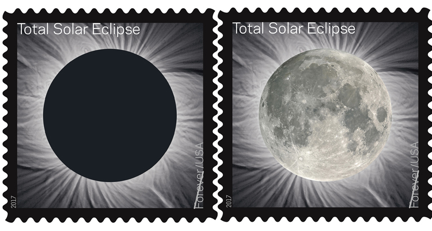Power to the people: New heat-sensitive stamp puts eclipse in your hands
Published 10:05 am Saturday, June 17, 2017

- Solar Eclipse
The innovative new Total Solar Eclipse of the Sun stamp from the U.S. Postal Service, which turns from darkness to light when touched with a fingertip, will be available for purchase on June 20. This release coincides with summer solstice – the longest day of the year in the Northern Hemisphere.
The first U.S. stamp printed using thermochromatic ink commemorates the upcoming solar eclipse. Tens of millions of people in the U.S. are expected to view the rare event on August 21, 2017 the first time a solar eclipse has crossed the entire U.S. since 1918.
The body heat of your finger or thumb activates Thermochromatic ink. When rubbed, the image of the eclipsed sun on the stamp reveals an underlying image of the moon. The image reverts back to the eclipse once it cools.
A first-day-of-issue ceremony is scheduled at the Art Museum of the University of Wyoming in Laramie at 1:30 p.m. MT on June 20. A unique feature of the museum’s architecture allows a shaft of sunlight to shine on a silver dollar embedded on the floor of the rotunda gallery.
The stamp’s image is a photograph taken by Fred Espenak, a retired NASA astrophysicist and avid photographer known as “Mr. Eclipse.” The image shows a total solar eclipse on March 29, 2006, as seen from Jalu, Liba.
Art director Antonio Alcalá, an art director in Alexandria, Virginia, designed the stamp.
The total eclipse of the sun provides a rare opportunity to view the corona of the Sun, the star’s extended outer atmosphere, without using special instruments. During an eclipse, the corona appears as a white, flower-like structure extending into space. The corona can be seen clearly on the new stamp.
The eclipse path will traverse a narrow slice of the country from Oregon to South Carolina, including 14 states. A map of the 70-mile-wide “path of totality,” where the sun will be completely blocked as the moon passes between it and the Earth, will appear on the back of each 16-stamp pane.
The Total Eclipse of the Sun Forever stamp is undenominated (49 cents) and will be available only as a pane of 16 stamps. The Postal Service will offer collectors a limited number of press sheets featuring eight unsevered panes.
Two versions of a first-day-of-issue Total Eclipse of the Sun stamp pictorial postmark will be available to collectors for 60 days through the mail. Find more information online or call 800-782-6724.
The ink can be damaged by UV light and should be kept out of direct sunlight as much as possible to preserve its power.
At the time of summer solstice – from the Latin words sol (sun) and sistere (to stand still) – Earth’s axis of rotation, the imaginary line that connects the North Pole to the South Pole, is most inclined toward the Sun. Viewed from the north or south pole, the Sun reaches its highest altitude of the year on summer solstice.
The event happens twice a year, once during summer in each hemisphere. The same date in the opposite hemisphere is called winter solstice. The precise time of the 2017 solstice is 12:24 a.m. Eastern Time on June 21.
© Content That Works





